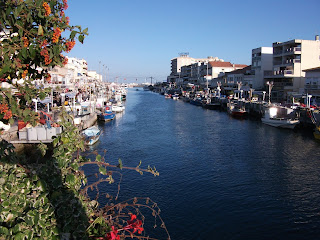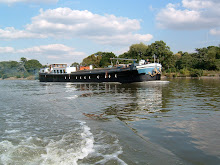Left the bright lights and big noise of Palavas Les Flots and continued down the Rhone a Sete canal towards Sete itself.
 |
| Palava les Flots at night : just like Blackpool! |
Reached a fork in the canal and had to make a decision : straight on to Frontignan and the slow route to Sete or turn off down the commercial channel and head out to sea and the coastal route into Sete.
The wind and waves were not appealing, despite the somewhat protected coastal route. And we still were unsure about where we would actually be able to moor. So we opted for the quiet resort of Frontignan and found a convenient, free mooring in town. Frontignan is considered to be the home of the Muscat vine and conveniently within 40 paces of our mooring is a cellar which offers free tastings and wine for sale “en vrac” (in bulk).
*Please note : the return trip to the barge is 83 and a half paces.
The quay is popular with locals out for a stroll and Lobelia soon drew a crowd.
All was well.
Until the curse of three hit.
1. Andy noticed a small leak in the pipes connecting our fresh water tanks which hold about 6 tons of precious drinking water. Tightening the joint had made matters worse. Finding appropriate UK fittings in our box of spares was proving tricky. Buying new ones in France impossible. Then another leak – just out of arm’s reach from the first one. Bring in team plumber Shiv. The now steady dripping of water required the biggest saucepans. Isolating the leak sites from the 6 tons of water also proved to be a headache. Andy locked off the first 3 tons but there was no way he could do the same with the rest. It all reverted to thumbs, fingers and palms of hands. In the heat of the day with synchronised giggles, violent spurts of water, a few curses and some deft handiwork we managed to replace the faulty pipework.
But it crossed our minds that if that had failed then we would still be down in the bilges with our hands holding back the flood. I wonder how long it would have taken the boys to miss us?
2. The wind had become a stiff offshore breeze and the already low canal levels suffered as a result. The level in the canal dropped a foot or more. Our comfy canal mooring was no more. Lobelia was now sitting at a jaunty angle thanks to the silted up edge of the canal and water was running off the draining board in a whole new exciting way.
We spoke to the Capitainerie and they assured us that there were no tides to worry about. But Lobelia’s list did not lessen. A makeshift pendulum in the galley marked her change in degrees. The locals who had originally come to admire Lobelia now came to stare and point.
We got used to walking around the boat at a crazy angle and had faith that the problem would sort itself out once the “moon was right and the tide was right” (thank you Shaldon Players).
It took a couple of days and eventually Lobelia sat pretty once more – but just a little bit further from the quay this time.
We celebrated by bedecking the mast with flags and bunting. The locals returned to point, nod and smile again. We raised a glass of local warming Muscat wine.
 |
| Lobelia flies the Devon flag |
3. Cycled to the beach, burdened with rucksacks of towels and toys and treats and set up camp. Dan and Cal raced into the sea and within 30 seconds were screaming in agony. Cal seemed to recover but poor Dan did not. Large doses of Paracetamol did not alleviate the pain in his foot and we could not see anything there. A trip to the first aid post on the beach was needed. Dan was treated quickly and efficiently with a hot salty foot bath. Apparently he had stood on the barb of a sea creature and the hot water would help to remove it. Twenty minutes later and he was much better.
Whilst this was happening Andy and Cal went off to retrieve our bikes and belongings from the beach about a kilometre away. Cal nobly agreed to ride Dan’s new bike back along the road to the first aid post. It was only once he started riding it on the road that he turned to Andy and said, “Daddy, you know that I cannot reach the floor… well, I cannot reach the brakes either!” Andy made a quick call to Shiv and together they made a synchronised emergency braking system with braced legs and outstretched arms on a zebra crossing in the town! No need for any more first aid.
We returned to the boat.
The curse of three was over.











































